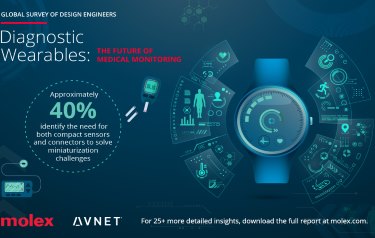
Global electronics company Molex has announced the results of a global survey of design engineering stakeholders aimed at identifying the market forces that are driving the development of diagnostic wearables – devices that enable patients, caregivers and consumers to monitor and analyse data regarding health status.
Survey respondents cited high expectations for consumer use and innovation in wearables for sport and fitness, wellness and medical-monitoring applications. They also identified the regulatory, technological and adoption barriers that must be cleared to fuel the advancement of increasingly connected, smaller and more powerful health, fitness and medical-monitoring wearables.
‘There’s an interesting convergence taking place across the diagnostic wearables landscape as medical device companies and tech innovators strive to bring game-changing products to market,’ said Tyson Masar, global director, medical, at Molex. ‘Emerging applications dictate new requirements, which is why design engineers must understand the needs of all stakeholders and how they affect decisions across the entire product lifecycle – from early-stage device design concepts to commercialisation at scale and every step in between.’
Molex’s Diagnostic Wearables: The Future of Medical Monitoring global survey, carried out in August 2022 together with Avnet, involved polling 603 qualified individuals in design engineering roles with responsibility for diagnostic wearables. The survey was designed to understand the pace of adoption and impact of a growing ecosystem of advocates while also assessing the challenges and trade-offs that are impeding product delivery.
A growing roster of advocates are encouraging increased use of diagnostic wearables, led by patients and consumers (61 per cent), doctors and other medical professionals (47 per cent) along with in-home caregivers (44 per cent). Unsurprisingly, insurance providers, some doctors and other medical professionals, as well as medical technicians, remain hesitant or object to increased use. However, design engineers reported high expectations that within the next five years they will see direct consumer adoption of devices to support obesity control (61 per cent), posture sensing and correction (59 per cent), breath-based disease detection (51 per cent), reproductive health monitoring (50 per cent) and infectious disease monitoring (49 per cent). Examples of new medical wearables expected to be available within five years include devices for tracking diabetes, sleep monitoring, gait analysis, genetic abnormalities and vision deterioration.
Despite optimism for the future, the design challenges identified by participants included consumer expectations for ease of use (42 per cent), the need for simple user interfaces and complete documentation (41 per cent), design difficulties in uncontrolled homecare settings (40 per cent) and complexity of regulatory approval processes (34 per cent). Areas that are also seen to impede design processes include cost (38 per cent), durability (37 per cent), power (35 per cent), miniaturisation (33 per cent), data capture (30 per cent) and connectivity (30 per cent). In fact, three-quarters of those polled report that connectivity constraints have a negative impact on current abilities to collect relevant data for tracking and analysing health.
According to those polled, the top five impediments to designing smaller wearables range from miniaturising the sensing elements (40 per cent) and making hardware, such as connectors, smaller (39 per cent) to power management (32 per cent), signal quality (29 per cent) and thermal management (22 per cent). The top three most reported innovations in materials were biocompatibility, published functional and reliability data for emerging materials, and real-world ‘wear test’ simulations.
Overall, respondents were bullish about the potential for harvesting patient energy to power wearable functionality. While acknowledging that time and innovation will be required to propel this area forward, respondents cited movement (49 per cent), body heat (35 per cent) and perspiration (13 per cent) as the most viable sources for energy harvesting.
According to 63 per cent of those surveyed, strong collaboration among industry, government and academic groups is expected to drive most innovations in diagnostic wearables. While nearly three-quarters of respondents from China ranked group collaboration highest in importance, results from participants in the UK (52 per cent), France (57 per cent) and Germany (59 per cent) were more closely aligned with participants from the USA (61 per cent).
The full report can be downloaded here.


